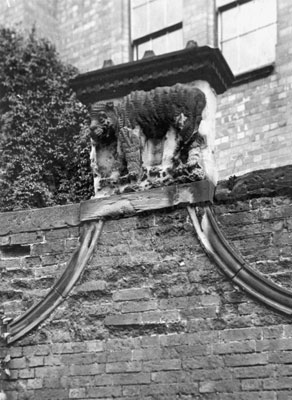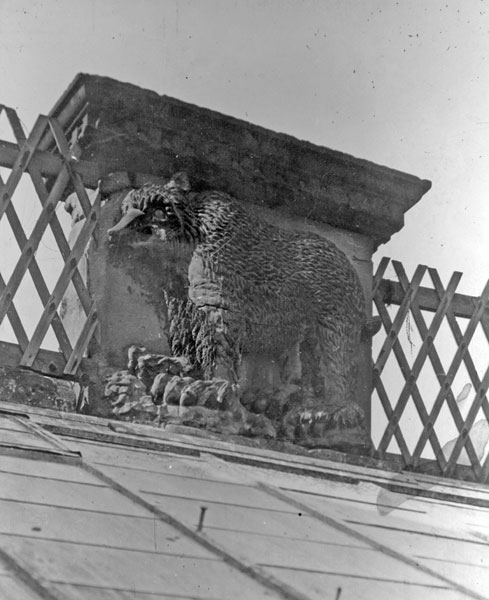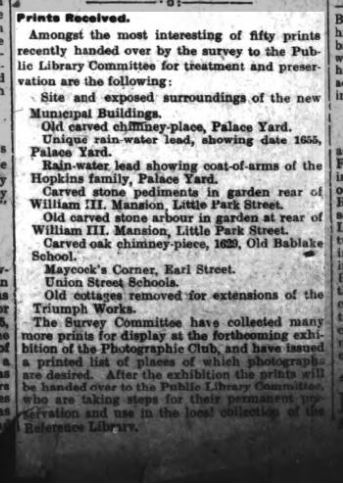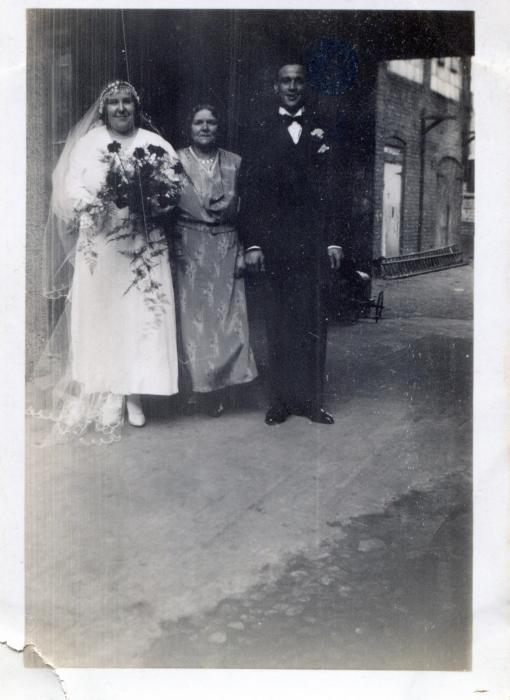

|
NeilsYard
Coventry |
91 of 240
Tue 22nd May 2018 7:28pm
Thanks Anne - IIRC I think Dutchman mentioned a while ago it was believed to have been around that time it was moved. I'm just intrigued about it and the surrounding 'Beasts' that Robs collection shows below. Why would it have been moved to Coventry - it appeared to be a large structure and the surrounding stone animals suggest a larger garden/building. Fascintaing all the same! I've searched on old maps for a location without success. The 'carvings' appear to be very well done.

 |
| Streets and Roads - Little Palace Yard | |
|
Prof
Gloucester |
92 of 240
Tue 22nd May 2018 7:51pm
What a fascinating subject! I recall the photo in Levi Fox's 'Coventry's Heritage' which I have mentioned before. Apsley Guise also jogged a memory as a great aunt of mine was in service at a house there perhaps in the 1920s and she was later housekeeper to an Anglican clergyman in Thorpe Malsor. Agree with Neil re the carvings which are very sharp. |
| Streets and Roads - Little Palace Yard | |
|
Helen F
Warrington |
93 of 240
Tue 22nd May 2018 7:59pm
Possibly it's not all from one source. The animals look Indian but the arbour is medieval in style. There was a lot of salvage from the three demolished monasteries and also I think that some of the more fanciful stuff was stripped out of the three remaining churches. It might be a meld of old and new or it might have been commissioned from some foreign stone carvers on someone's grand tour.
Rhino drawn in 1515
If there were no representations of the Indian rhino before 1515 it's unlikely to have been carved before the dissolution and it probably didn't come from a tomb afterwards.
Neil, the arbour was at the very end of the garden. I could work out which wall the other three animals sat on if you really want to know. |
| Streets and Roads - Little Palace Yard | |
|
NeilsYard
Coventry |
94 of 240
Wed 23rd May 2018 9:41am
I'd love to know Helen. I know Rosemary recalls the tree at the end of LPY which led across to the garden. Shame the other 'animals' were not saved - unless they are in someone else's garden which did happen! I used to live by Berkswell Hall when that was converted in to accommodation. The Iron Fountain that was in the Hall was taken by the builder/developer and installed in his house on Stoneleigh Road near Leamington. |
| Streets and Roads - Little Palace Yard | |
|
Annewiggy
Tamworth |
95 of 240
Wed 23rd May 2018 11:41am
In September 1944 Angela Brazil, former hon. secretary of Coventry City Guild, wrote in the C.E.T.
The old stone lion formerly on the old stone arbour in Little Park Street and later in the City Guild Museum was removed to the Memorial Park and was incorporated in the porchway there which was blitzed in 1941. The lion was not damaged and was placed on the ground near and slightly protected with a slab of stone. I regret to say that boys have removed the covering and have done serious damage to the figure of the lion. Before it is entirely destroyed cannot it at once be taken to a place of safety as a relic of "Old Coventry". So few of these now remain and they should be preserved. |
| Streets and Roads - Little Palace Yard | |
|
Helen F
Warrington |
96 of 240
Thu 24th May 2018 10:00am
One of the things I think I've identified is that the other animals may have been removed some indeterminate time before the arbour. Probably because the walls were falling down. That may have prompted someone to photograph them. The only animal I can properly locate is the tiger, which was on the north wall, fairly close to the east wall in front of which the arbour stood. That then suggests that there might have been an animal opposite on the south wall. The Georgians were all about symmetry. There were a lot of changes to the surrounding plots in the years during which the animals may have been removed, so working out the clues from the images are tough to link to the maps. I think they may have been moved between 1906 and 1913. If that is the case (or if they were moved earlier) then the bear is above a lean to building as you can see the roof. The only buildings that seems to fit were at the west end of the north wall, very close to the stable, (north west wing of the H shape of the Little Palace Yard). The elephant picture has trees in the back ground which could be either end of the south wall but I favour the east end. The rhino is photographed on the ground, probably because it was in danger of falling. The south west end of the wall had a gap into the next door garden in 1850 (perhaps they were all owned by the LPY originally?) Maybe that weakened the wall and it was the first part of the wall to crumble? That might explain why the rhino was moved first? In 1913 there was a factory built to the south of the garden and would have been visible in the photograph of the elephant.
So to summarise. The bear on the north wall at the west. The tiger on the north wall, east. The arbour on the east wall. The elephant on the south wall, east end. The rhino on the south wall, west end.
Maybe.
|
| Streets and Roads - Little Palace Yard | |
|
NeilsYard
Coventry |
97 of 240
Thu 24th May 2018 10:18am
How do you know all this Helen! |
| Streets and Roads - Little Palace Yard | |
|
Helen F
Warrington |
98 of 240
Thu 24th May 2018 11:20am
I got a lotta maps. |
| Streets and Roads - Little Palace Yard | |
|
Annewiggy
Tamworth |
99 of 240
Thu 24th May 2018 11:32am
This article is dated 14th March 1914 from the CET. Could this have been when some of the pictures of the stones were taken? Does this collection still exist? I am confused as to which is Little Palace Yard and Palace Yard and what they describe as William III Mansion, Little Park Street!

|
| Streets and Roads - Little Palace Yard | |
|
NeilsYard
Coventry |
100 of 240
Thu 24th May 2018 12:14pm
Brilliant stuff Helen / Anne |
| Streets and Roads - Little Palace Yard | |
|
Annewiggy
Tamworth |
101 of 240
Thu 24th May 2018 12:24pm
So William III Mansion would be Little Park Street? I have just read an article by Mary Dormer Harris in which she says "Adam Court, which some call Little Palace Yard" |
| Streets and Roads - Little Palace Yard | |
|
Helen F
Warrington |
102 of 240
Thu 24th May 2018 1:24pm
It took me a while to work out that there were two palace yards.
Yes, I think that the Little Palace yard is William III's mansion. He was born 1650 and died 1702. The buildings were originally medieval and at some point they were 'modernised' and the style is consistent with William III's era. I think the style is called Palladian. The front and very back of the Palace Yard were of a similar era but the inner part of the Palace Yard was only updated in 1656 (ish) and was perhaps too good to change. Whether William III owned both is a good question. That would make it reasonable that there was one big garden from one property to the other. By that era Little Park Street was more well to do than Earl Street and it wouldn't be odd that that part was the prime residence and not the Earl Street property. It was certainly quieter.
I hadn't come across Adam Court but it was common for the courts to be named after whoever owned the property at the front and/or their business. Was there such a person in Mary Dormer Harris' day? |
| Streets and Roads - Little Palace Yard | |
|
NeilsYard
Coventry |
103 of 240
Thu 24th May 2018 4:06pm
Thanks to Rosemary on here - this is the entrance to Little Palace Yard looking in from Little Park Street and shows my Uncle Ray - one of my grandfather's brothers - and his wife Wyn on their wedding day. Rosemary is related to Wyn, hence the connection! As per earlier comments on this thread they lived in part of LPY right up until they were subject to the clearance order and forced to relocate when LPY was demolished to make way for the Police Station.
 After re-reading this thread (has it been going that long!) I'd forgotten about Anne's clipping in Post 48 which states the Arbour was part of Whitefriars. It could easily have led across towards where Whitefriars Gate is so makes sense to me. Does anyone have a larger copy of the clipping Herberts Lad posted (post 9) of the Arbour in the Memorial Park before it was blown up?
After re-reading this thread (has it been going that long!) I'd forgotten about Anne's clipping in Post 48 which states the Arbour was part of Whitefriars. It could easily have led across towards where Whitefriars Gate is so makes sense to me. Does anyone have a larger copy of the clipping Herberts Lad posted (post 9) of the Arbour in the Memorial Park before it was blown up? |
| Streets and Roads - Little Palace Yard | |
|
Prof
Gloucester |
104 of 240
Thu 24th May 2018 4:15pm
Yes, Baz, the Princess Elizabeth, daughter of James Ist was living at Coombe Abbey, the home of Lord Harrington, where she was being educated as a child. When news of the Gunpowder Plot reached Coventry she was brought within the city walls for safety and stayed at Palace Yard, owned I think by someone called Hopkins. She later became the tragic Winter Queen of Bohemia and lived with her husband Fredrick V of the Palatinate at Heidelberg Castle. Her husband lost the battle of the White Mountain near Prague, which meant the Protestant cause was lost against the Catholic Europe. Widowed, at the end of her life she lived in London in impoverished circumstances. This may have caused confusion with references to Queen Elizabeth I who visited Coventry and perhaps Palace Yard as well as the Whitefriars, but she would hardly have stayed there as she is known to have stayed at Kenilworth Castle and made her progress to Coventry. |
| Streets and Roads - Little Palace Yard | |
|
Annewiggy
Tamworth |
105 of 240
Thu 24th May 2018 7:03pm
But I am getting confused again (doesn't take much!) Didn't Hopkins own Palace Yard not Little Palace Yard ? |
| Streets and Roads - Little Palace Yard | |
This is your first visit to my website today, thank you!
3,577,249Website & counter by Rob Orland © 2024
Load time: 40ms